 ™
™
TRADITIONAL MOUNTAINEERING
™
www.TraditionalMountaineering.org
™ and also
www.AlpineMountaineering.org
™
 ™
™
FREE BASIC TO ADVANCED ALPINE MOUNTAIN CLIMBING INSTRUCTION
™
Home
| Information
| Photos
| Calendar
| News
| Seminars
| Experiences
| Questions
| Updates
| Books
| Conditions
| Links
| Search
![]()
Click on an image to see the full version; broadband folks can click here to see the full sized page.
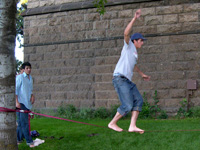
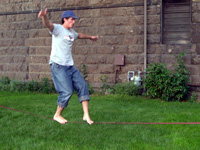
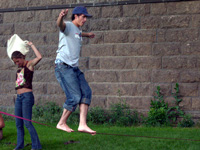
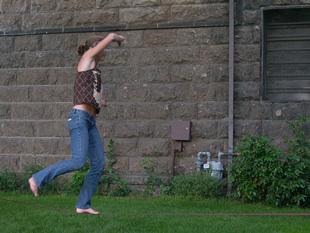
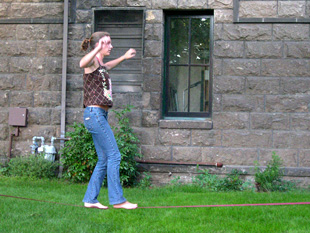
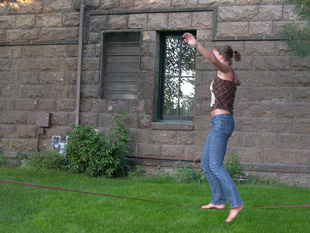
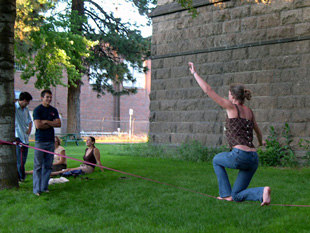
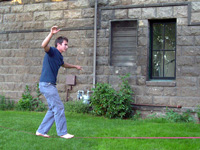
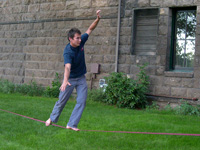
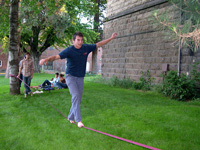
Copyright© 2004 by Robert Speik. All Rights Reserved.
SLACKLINING
I saw these folks playing on a slackline on the lawn next to the
Heritage Museum in downtown Bend. They are students at the University of Oregon.
They asked me to try it out but I thanked them and declined. (I really
appreciated being asked. It was a little like my being carded at a concert refreshment booth.) They gave me
their names which I didn't write down and I would be happy to record them here (and
email them some of the free original large format images suitable for printing) if they will send me an
email.
"Hey! this is the girl from all of your pictures of slacklining, my name is krystal and the other dude in the blue shirt is brian! we all learned to slackline this year in bishop california for spring break! then when we got home brian bought one, then all of us got them. the second guy in the pictures is chris. thank you so much for putting our pictures up on the web site, my dad really enjoyed them. if you have any other questions let me know and id love to keep corresponding." --krystal
Note: I am working with Molly Graham, a reporter/producer for Z21 NBC News to do an outdoor sports piece on all these fine folks for the six o'clock News sometime soon. Stay tuned and watch the Calendar. --Webmeister.
Slacklining is one of those games climbers played in Yosemite during the great days of traditional big wall climbing epics. Camp 4 saw the early development of slacklining and the Hacky Sack as well as big wall climbing.
In the late 1990s, Yosemite's Camp 4 was preserved from National
Park Service development by a lawsuit for the traditional climbers who lived the
romance of this era.
Read more at
Here is a description of the origin of slacklining and
highlining from
The
Slackline Brothers web
The Evolution of Slacklining by Chris Carpenter
In constant pursuit of equilibrium, we go through phases of change and
adaptation. Constantly being reminded by gravity; we choose many means to flow
with that reality.
Slackliners are helping to take this one step farther. While walking, bouncing
or swinging on a flat piece of tubular nylon webbing, we are constantly playing
with that delicate difference between on and off. We were the pioneers in the
field of slackliners, and our accomplishments from the early days are only now
beginning to fuel the passion for balance within others.
It was the summer of 1983. I was in Yosemite National Park, CA with my best
friend Scott Balcom doing some rock climbing, backpacking and living. One late
afternoon
while kicking back in the Yosemite Lodge parking lot we spied somebody setting
up what looked to be a tight rope. Adam Grolkowski was his name, and he just
seemed to hop right up on that line. He walked a few times from one end to the
other. Then he settled in and started to purposefully swing back and forth on
his "slackline." Now this was impressive; almost dance like. Scott and I had
been doing some balance type walking on handrails, parking lot chains and such.
Scott's brother Ric even had a
one-inch hemp rope we messed around with back in 1977. Yet we had never seen
anything like this before. Adam really seemed quite comfortable swinging back
and forth
while listening to his Walkman, and I don't remember him falling off much
either.
Adam was in the valley that year with his friend Jeff Elington. Also an
accomplished slackliner, Jeff would set up his slackline parallel to Adam's.
They both preferred to walk on 3/4 inch flat nylon lines at a length of about 20
feet. And the two of them had a juggling act where they would balance on one
foot and pass juggling clubs to each other. It was fun to watch. They made it
look so easy. Adam was also working on doing a handstand on the slackline.
Without any assistance, he could push into and hold a handstand for a few
seconds. There was nothing about this feat that looked at all easy. Now Jeff and
Adam were not in Yosemite Valley to show off their talents. They were there for
a purpose, and that was to walk the Lost Arrow Spire 2,900 feet above the valley
floor. They had brought all the necessary hardware including a very heavy
sixty-foot length of metal cable. Despite the fact that both men were very
talented line walkers, the Lost Arrow Spire was not successfully completed that
summer of 1983.
Upon returning from Yosemite that summer, Scott and I both purchased our own
slacklines from the local mountain shop. We both started walking one inch
tubular nylon
webbing, and for the next year, spent nearly every weekend slacklining together.
Scott proved to be the most talented on slackline within our group. Chuck
Tucker, Darrin
Carter, and Ric Phiegh were messing around with slacklining a little back then.
Yet Scott and I were the ones who continually pushed each other. So together,
behind the
mastermind of Scott's ingenuity, we experimented with a number of different
lines and lengths. The 9/16th super tape at a 45-foot length was our favorite.
This line proved to
be very springy and especially good for swinging on. We also walked 2-inch
webbing at a length of 80 feet. We walked on and broke a 30-foot length of
tubular bootlace.
(Warning! Be careful with bootlace. It can leave welts.) We strung and walked a
118-foot length of one-inch webbing (very much like walking on the moon). And we
also
experimented with doubling up the lines. Scott strung bootlace within bootlace;
we never did break this one. We also tripled the lines. This process involved
stringing two
9/16th lines through the inside of a 1 inch tubular line. This tripled line was
our strongest slackline that we later used for highlining.
As you can guess, highlining involves walking slackline up high. We still had
that visual image of Jeff and Adam wanting to walk "The Spire." Yet Adam and
Jeff had made
the attempt with cable, not slackline. While the cable was strong, it proved to
be too difficult at this length without guy lines. Therefore, our
experimentation proved worth
while in the pursuit of slackline accomplishments.
It was the fall of '83. Scott was 20 years old and I was 17. Together, with the
help of "Ironman Rob" Slater, Ric Phiegh and Chuck Tucker, we set up our first
highline. The
location was at our favorite rebel hangout we called "The Arches" (a towering
structure of freeway overpass located near the Rose Bowl in CA). The underside
of this freeway was the perfect starting ground. Perched at about 80 feet off
the ground, we set up a 2-inch wide slackline strung at a length of about 22
feet. Once secured we had Rob try the line first. Rob was one of those fearless
types. An extremely successful aid climber, he had barley practiced walking the
slackline for maybe 15 minutes in Scott's front yard. So, sure enough, he fell
off, and we now knew for certain that our line could sustain a healthy fall. I
was next in line to give it a try. Secured to the slackline with a swami belt
and tether, I made it out three steps before I was grabbing the line and
swinging into big air. Now Scott had watched two of us fall off, and he came up
with a great idea. He rigged a second line just above his head stretching
lengthwise. While holding the line above, one felt much more comfortable with
the start. Focused and well balanced before letting go, Scott successfully
walked across the first ever slackline highline. After he completed his first
attempt, I also successfully completed the walk. Charged by our success,
we did the walk a couple more times that day without the use of a guideline.
Ric, Chuck and Rob also traversed the line, yet they held onto the guideline
above for balance. Actually, Chuck held on with two hands while being double
belayed. With this first highline completed, we helped pave the way for future
highliners.
Scott and I returned to the Arches to walk the highline a number of times in '83
and '84. Yet now the reason for going back was to practice for the ultimate
highline, the Lost Arrow Spire in Yosemite. Walking 2,900 feet in the air is an
art form all its own. And, I would have to say that Scott was by far the most
driven to complete this highline walk. He had designed a very strong highline
(tripled line), and he reproduced the span of the walk while practicing with
pure focus.
That summer of '84 was the first year we went up to walk the Lost Arrow Spire.
Our crew for that trip included Darrin Carter, Bob the Aid Man, Scott and Me.
Darrin and Bob did the necessary rock climbing out on the spire, while I
remained back on the rim of the granite wall to take pictures. The day was epic.
We had a slight breeze and lots of sun. Once the line was rigged to go Scott
contemplated the walk for what seemed like hours. I watched from a distance as
Scott gave it his first try. He turned back
immediately. Scott balked a number of more times until he really committed
himself to go. Once he committed, however, he made it out a couple of steps only
to try and
jump back to his starting ledge. He lost his grip and proceeded to slip into the
void of swirling air and height exposure. I seem to recall him screaming. He
was, of course,
caught by his safety line. A bit shaken, he did try it a few more times
unsuccessfully. I, however, didn't really have the desire to try it myself after
watching him flail around
out there. It proved scary enough for me just watching it happen. So the Lost
Arrow Spire had once again foiled any highline attempt for another year.
The next year, however, was another story. Scott changed his focus from pure
balance, to a more holistic approach of mental visualization, line and distance
perception and
of course a balanced regimen of practice. My passion for highline, however, was
beginning to wane at this time. I was a senior in high school with college
knocking at my
door. I was urged by Scott to return with him to Yosemite that summer of '85,
yet I declined and moved to San Diego in pursuit of my own independence. As a
slackliner, I
had accomplished my goals. "Swing walking" close to the ground and riding the
line were my specialties. Highlining, while extremely rewarding, just wasn't as
fun for me as swinging. Scott, however, was driven. He returned to "The Spire"
that summer and recruited his friends Matt Dancy and Ken Klis as the climbing
crew. Another
acquaintance, Paul Borne, showed much enthusiasm and was brought along to help
rig the highline.
Scott and Paul rigged the line late in the afternoon July 12, 1985. The day was
very breezy and the wind continued to blow throughout the night. The next
morning at 8:00 am the breeze died down. Now was the perfect time. Early
morning, fresh and ready to go, Scott rappelled down to the highline. He
traversed the line Tyrolean style so that he could walk from the spire to the
Valley wall. Once in place and secured to the highline, Scott took his time to
mentally prepare himself. He could feel the confidence swell within himself.
This was not new to him. He had stood here before, and he was truly lusting to
reach the other side. There were a number of false starts; but this year, he
could nimbly jump back to the spire with ease. On two different occasions he got
out as many as five steps only to fall, grasping firmly to the line with his
hands. Hardly
shaken from the events his determination pushed him. Again, being five steps
out, he could feel himself loosing his balance. Yet this time something clicked
within his mind. Instantly his consciousness switched to the Zen of "the here
and now" as he puts it. He had been lusting for the other side instead of being
comfortable with where he was NOW. Simultaneously he regained his balance and
composure. Virtually focusing on putting "one foot in front of the other," this
mantra spoke comfort to him. He had now walked 45 of the 55 foot walk, and he
was feeling pretty certain he would make it. From the gallery of viewers there
was uncertainty and complete silence, except for the clicking of camera
shutters. The smile on Scott's face grew. With calm resolution, he gracefully
took his last step to the granite ledge that had eluded him the year before. The
jubilation was enormous. Scott Balcom had successfully walked the Lost Arrow
Spire July 13, 1985, and with that walk inspired the growth of highlining on
slackline as we now know it.
Without a doubt, the person most inspired in the field of highlining is Darrin
Carter. I have known Darrin since I was eleven years old. Through the years, I
have been fortunate to witness his character and skill come to fruition in the
field of slacklining. Darrin was around in the early days. He accompanied us on
an Arches attempt, walking with the help of a guideline. He would come over and
slackline with us in the front yard on occasion also. But the seeds were not
truly planted until he watched Scott fail his first Spire attempt. Once those
seeds were planted though, Darrin within the next decade had proven himself to
be the top highline contender. Darrin made the Lost Arrow Spire his first
highline adventure. An extremely high goal to obtain, the Spire proved
unattainable for Darrin the first time he attempted it in '92.
Darrin, however, was never one to back down. Returning the summer of '93 he
successfully crossed that elusive chasm, and he was now the only other person to
walk the
Lost Arrow Spire in Yosemite. Darrin's domination in the sport of highlining,
however, didn't really come about until he moved to Tucson, AZ in 1995. His
training ground was a rock formation in the Santa Catalina Mountains called the
Fins. Scott had attempted a walk at this location in 1987 with no success.
Darrin returned to that same spot with Scott in April of 1995. With absolute
determination and the intended domination of his goal to become the ultimate
highliner, Darrin made eight consecutive one way crossings of this 65-foot span.
Scott made one. A demon inside Darrin was born. He could feel within himself
that his purpose in life now made sense.
With bold conviction, Darrin made multiple trips to the fins over a number of
weeks and made highlining his life's work. He was a machine. He was also the
first person to
ever turn around on a highline and successfully walk back the other direction
without falling. Scott had made a turn on a highline, yet was unable to maintain
his balance
there after. Darrin's focus naturally shifted to mastering the Lost Arrow Spire.
The 10th year anniversary of Scott's crossing of the Spire became Darrin's
target date for his Spire mastery. Darrin made his training for this new goal a
job. His highline
technique truly became flawless. He built within himself this incredible ability
to block out the majority of fear that is associated with walking up high.
Cutting off his survival
instinct, he uses a warrior attitude to help cope with the intensity of walking
surrounded by big air. Darrin made his return trip to the Spire in July of '95
with complete
confidence and intensity. Scott accompanied Darrin's crew of friends that
included Chuck Tucker and Tim Kirkwood. On the actual day of the walk, Darrin
was like a caged
animal waiting to be cut loose. Pacing, barking instructions, impatient and
ready to go, Darrin had a unique way of psyching himself up. The brunt of his
intensity was aimed at Chuck Tucker (also present to walk the Spire that day).
Chuck, however, passively let Darrin do his thing while Scott Balcom and Tim
Kirkwood assisted with the line setup.
Once the line was ready to go, Darrin did just what he had set out to do. He
walked the hell out of that line. Very confident and in the now, Darrin walked
with smooth solid
technique. First he made a number of one way crossings. Then he really got in
the groove and started turning around, walking back and forth. On one occasion
he even
walked for about 20 minutes without stopping. Scott made a crossing for old time
sakes. Chuck Tucker also managed to get across, with his very unorthodox
slacklining
style, for the second time (He successfully walked the Spire in 1994 his first
time). Now that Darrin had mastered the Lost Arrow Spire, he did take it one
step further. It was the sort of thing one thinks about yet rarely tries.
I am not sure of the dates, but I do know that Darrin has now made eight separate crossings of the Lost Arrow Spire without a leash for protection. Imagine yourself 2,900 feet in the air, on two pieces of flat nylon webbing walking for the sport of it with nothing to catch you if you fell. Now that is intense. Personally, it is very hard for me to even conceive. Walking free hand, without a counterbalance pole, unprotected at that location, I truly doubt that there will be another person for quite a few years that will reproduce that incredible feat. So with the years behind us and nothing but time ahead of us, we look forward to the continued development of slacklining. Handstands, juggling, swinging, dismounts and, the ultimate rush, highlining can breathe new life into extreme sports, and this sport is still so incredibly new.
As individuals, we balance on a regular basis, and it is only
natural that we take and nurture that ability. As slackliners, we balance with
focus and purpose in pursuit of confidence and accomplishment. So give it a try.
Be it walking a slackline; debating an issue, or even helping a kid to ride a
bike, the equilibrium of life is in flux. Discovery of the boundaries between on
and off helps everyone in the long run.
Remember, It's "Just One Foot In Front Of The Other"
XXXXXXX
![]()
Read more . . .
EXPERIENCE REPORTS - SMITH ROCK
Smith Rock - WARNING - top rope belay error
Smith Rock - inadequate top rope belay
Smith Rock - climber injured on the approach
Smith Rock - WARNING - belayer drops climber off the end of the top rope
Smith Rock - novice sport climber injured
Smith Rock - fall on rock, protection pulled out
Smith Rock - fall on rock - poor position, inadequate protection
Smith Rock - pulled rock off - fall on rock, failure to test holds, exceeding abilities
Smith Rock - belay failure, fatal fall on rock
TRADITIONAL KNOWLEDGE
Who were the notorious Vulgarians?
How was top rope climbing practiced in the 1970s?
What is a Willans sit harness?
What is a dulfersitz rappel?
How do I self-belay a rappel?
The Sport of Traditional Alpine Mountaineering
"Traditional Alpine Mountaineering is basically an aerobic sport.
Climbing, jogging, running, hiking the hills, backpacking, mountain biking, back
country skiing, snowshoeing, telemark skiing, adventure racing and similar
sports all act together to improve aerobic capacity, strength, balance and
athleticism. Some of my companions were born with these gifts; I had to work
hard at improving my abilities and to climb well. What workouts are you enjoying?"